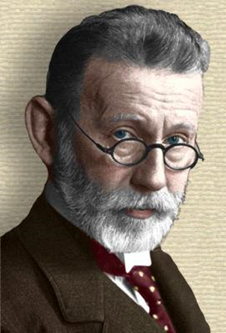PAUL EHRLICH
·
Paul Ehrlich
was the German Medical Scientist.
· Paul Ehrlich is
one of the most famous pioneer of the fields of Hematology, Immunology,
Pharmacology, Histology, Oncology and Chemotherapy.
·
Paul Ehrlich
showed that all the Dyes used could be classified as being Basic, Acid or
Neutral and his work on the Staining and differentiation of Granules in Blood
cells (distinguished Leukocytes from Neutrophils, Basophils and Eosinophils)
laid the foundations of Haematology and the Staining of tissues.
· In 1882, Paul Ehrlich
published his method of Staining the Tubercle bacillus (Mycobacterium
tuberculosis) (Acid fast staining) that Robert Koch had discovered and this
method was the basis of the subsequent modifications introduced by Ziehl and
Neelson, which are still used today.
·
While
developing new methods for the staining of live tissue, Ehrlich discovered the
uses of Methylene blue in the treatment of nervous disorders.
· Paul Ehrlich
developed his “Side-Chain Theory” (1897) and subsequently a “Receptor - Ligand
Concept”.
· Paul Ehrlich
also worked hard in the field of Passive Immunotherapy. For example, he contributed
greatly to the development of an effective Antiserum against Diphtheria and to
the approach of producing standardized Therapeutic Serum-Fractions. The
successful approach to standardizing biologically active substances was a great
breakthrough that supported the development of Immunotherapies.
· In 1902, Paul Ehrlich
and his Japanese colleague Kiyoshi Shiga explore the therapeutic potential of
different dyes. In 1904, their treatment with Trypan red stain was successful
in mice infected with Trypanosoma equinum (Sleeping Sickness). Unfortunately,
some Trypanosomes developed resistance to the dye and eventually killed the
host animal. Experiments in other animals, such as rats and dogs, were likewise
unsuccessful. Nevertheless, this work spurred Ehrlich's incessant search for
compounds with antimicrobial properties, and he next turned to organic arsenic
derivatives.
· In 1908, Paul
Ehrlich received the Nobel Prize in Physiology or Medicine together with Elie
Metchnikoff for their work and basic insights into Immunological Defense
Mechanisms. Both concepts formed the basis of Humoral and Cellular Immunology.
In particular, Paul Ehrlich was propagating a ‘Molecular Serum Theory' and Elie
Metchnikoff a ‘Cell-Phagocytosis Theory'.
· In 1909, Paul Ehrlich
synthesized a series of specific Antimicrobial drugs, the most famous example
being Arsphenamine (Salvarsan), the first Synthetic agent against Syphilis.
Paul Ehrlich is considered as the Founder of Chemotherapy.
· Due to the huge
success of this drug, Paul Ehrlich was able to popularize his new concept of a
‘Magic Bullet' (‘Zauberkugel'), a drug specifically targeting a particular
pathogen without affecting normal host cells.
·
A genus of Rickettsiales bacteria, Ehrlichia , is named after him.

Comments
Post a Comment